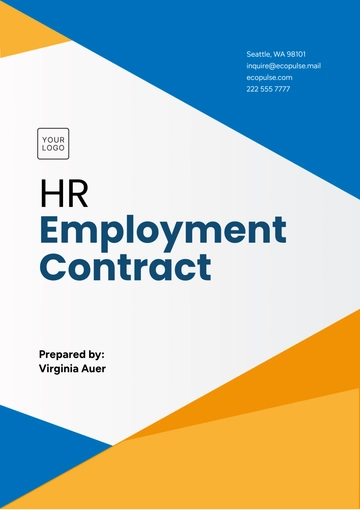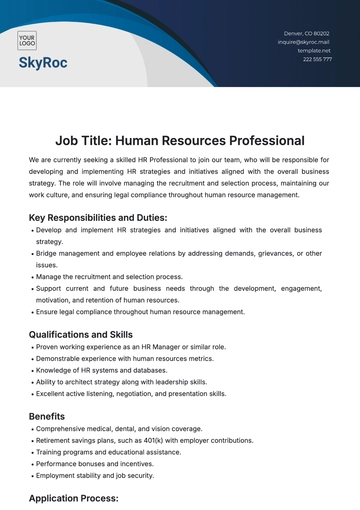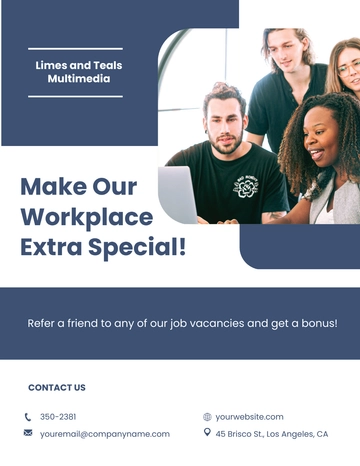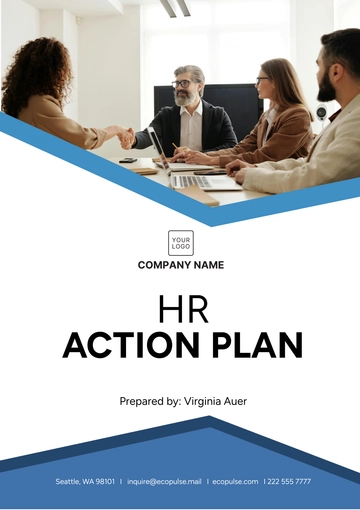Free Car Rental HR Strategy

I. Introduction
The Car Rental HR Strategy outlines our comprehensive plan to attract, develop, and retain exceptional talent for [Your Company Name]. Our primary goal is to build a high-performing workforce that supports our company’s mission, vision, and core values. By focusing on strategic recruitment, effective training programs, and competitive compensation, we aim to foster a work environment that not only meets industry standards but also drives organizational success. This strategy is designed to address the unique challenges of the car rental industry, including customer service excellence, operational efficiency, and innovation in service delivery.
To achieve these objectives, our HR approach will emphasize proactive recruitment techniques to attract qualified candidates, robust training programs to ensure ongoing employee development, and a comprehensive benefits package to support employee well-being and job satisfaction. We are committed to creating a diverse and inclusive workplace that values individual contributions and encourages professional growth. Through these efforts, we seek to align our human resources practices with our long-term business goals, ensuring that our team members are motivated, engaged, and prepared to deliver exceptional service to our customers.
II. Talent Acquisition
Talent acquisition is essential for building a strong team. This section outlines our methods for recruiting, selecting, and onboarding the best candidates to support our car rental business's success.
A. Recruitment Planning
Effective recruitment planning ensures we attract the right candidates. This section details our approach to analyzing staffing needs, defining job roles, and choosing the best methods for reaching potential hires.
Recruitment Planning Steps
Assess Needs: Determine how many new employees we need based on business goals and turnover.
Define Roles: Create job descriptions with qualifications, duties, and expectations.
Choose Methods: Decide where to find candidates, such as job boards, social media, and referrals.
Actions
Review staffing needs every quarter and adjust plans.
Write clear and appealing job ads.
B. Attracting Talent
Attracting top talent is crucial for building a successful team at [Your Company Name]. Our approach begins with developing a strong employer brand that highlights the benefits of working with us. We showcase our company’s culture, values, and opportunities for growth through a well-designed careers page on our website and engaging content on social media. By presenting a positive and appealing image, we aim to draw in high-quality candidates who align with our mission and values.
In addition to building our brand, we use a variety of channels to advertise job openings and reach potential candidates. This includes posting on popular job boards, leveraging social media platforms, and engaging in community events and job fairs. We also encourage employee referrals and explore partnerships with local organizations to expand our reach. Through these efforts, we strive to connect with diverse talent and find individuals who will contribute to our company’s success.
C. Selection Process
The selection process is crucial for hiring the right candidates. This section covers how we screen resumes, conduct interviews, assess skills, and check backgrounds to ensure the best fit for our roles.
Steps
Screen Resumes: Review applications to find candidates who fit the job.
Interview: Conduct phone and in-person interviews with candidates.
Assess Skills: Use tests to evaluate candidates’ abilities.
Check Backgrounds: Verify references and conduct background checks.
Actions
Follow a consistent interview process for fairness.
Train interviewers on effective and unbiased interviewing.
D. Onboarding
A successful onboarding process helps new employees start strong. This section outlines our approach to preparing for new hires, providing orientation, and delivering initial training for their roles.
Steps
Prepare: Send welcome materials and documents before the start date.
Orient: Introduce new hires to the company, their role, and the team.
Train: Provide training for job-specific tasks.
Actions
Create an onboarding schedule with key meetings and training.
Collect feedback from new hires to improve the process.
III. Onboarding and Training
Effective onboarding and training are essential for helping new hires become productive and successful at [Your Company Name]. Our comprehensive approach includes a structured onboarding program and ongoing training initiatives designed to support employee development and keep our team aligned with industry trends.
Onboarding Process
Welcome and Introductions
Orientation and Training
Mentorship and Support
These steps ensure a smooth and effective onboarding experience for new hires.
Ongoing training is equally important for employee growth and retention. We will offer continuous learning opportunities through workshops, online courses, and industry seminars. These programs will focus on developing new skills, enhancing job performance, and keeping employees informed about the latest trends and best practices in the car rental industry. By investing in our employees’ professional development, we aim to foster a culture of excellence and support long-term career growth.
IV. Performance Management
Performance management at [Your Company Name] is a crucial process designed to support employee success and align individual contributions with our company’s strategic objectives. Our approach includes setting clear expectations, conducting regular evaluations, and fostering ongoing development opportunities for our team.
A. Performance Expectations
Establishing clear performance expectations is essential for guiding employees and ensuring they understand what is required for success in their roles. At [Your Company Name], we start by defining specific, measurable, achievable, relevant, and time-bound (SMART) goals for each employee. These goals are aligned with our overall business objectives and are communicated through detailed job descriptions and performance standards. By setting these expectations, we create a clear roadmap for employees to follow and a basis for evaluating their performance.
Performance expectations also include setting key performance indicators (KPIs) that reflect how well employees meet their job responsibilities and contribute to the company’s success. This clear framework helps employees understand their roles, performance metrics, and how their work impacts the organization’s goals.
B. Performance Evaluation
Performance evaluations are a key component of our performance management strategy. They provide a structured opportunity to assess how well employees are meeting their goals and contributing to the company’s success. During the evaluation process, managers review employees' performance against the established goals and KPIs. This process involves a formal review at least once a year, complemented by regular feedback sessions throughout the year.
Evaluations focus on both the achievements and challenges faced by employees, offering constructive feedback that highlights strengths and identifies areas for improvement. This feedback helps employees understand their performance levels, adjust their efforts, and set new goals for future development.
C. Employee Development
Ongoing employee development is vital for maintaining high performance and preparing employees for future roles. At [Your Company Name], we are committed to providing opportunities for employees to grow professionally and advance in their careers. This commitment includes offering access to a variety of training programs, workshops, and seminars designed to enhance skills and keep employees informed about industry trends.
We work with employees to identify their development needs and career aspirations during performance reviews. By creating individualized development plans, we support employees’ growth and help them achieve their career goals. This approach not only enhances employees' job performance but also contributes to their long-term success within the company.
[Your Company Name] is dedicated to a comprehensive performance management process that sets clear expectations, provides effective evaluations, and supports ongoing employee development. Our approach ensures that employees are aligned with our business goals and have the resources they need for continuous growth.
V. Employee Engagement
Employee engagement is essential for creating a motivated and productive workforce at [Your Company Name]. Our approach focuses on fostering a positive work environment, encouraging open communication, and recognizing employee contributions to drive engagement and satisfaction.
A. Creating a Positive Work Environment
A positive work environment enhances job satisfaction and promotes employee well-being. We aim to create a workplace where employees feel valued, supported, and respected. This includes maintaining a safe and inclusive environment where team members can collaborate effectively and feel comfortable sharing their ideas and concerns.
Foster Team Collaboration: Encourage teamwork and open communication through team-building activities and regular meetings.
Promote Work-Life Balance: Support flexible work arrangements and offer resources for managing work and personal life.
Ensure Safe and Inclusive Practices: Uphold policies that prevent discrimination and harassment, and promote a culture of respect and inclusion.
B. Encouraging Open Communication
Open communication channels are vital for employee engagement. We provide various platforms for employees to share feedback, voice concerns, and contribute ideas.
Regular Feedback Opportunities: Implement mechanisms for employees to provide feedback on workplace issues and suggest improvements.
Transparent Communication: Keep employees informed about company updates, changes, and future plans.
C. Recognizing and Rewarding Contributions
Recognizing and rewarding employee achievements is crucial for maintaining high levels of engagement and motivation. We implement programs to celebrate successes and reward exceptional performance.
Recognition Programs: Establish formal programs to acknowledge and celebrate employee accomplishments.
Performance-Based Rewards: Offer incentives such as bonuses, promotions, and awards based on performance and achievements.
VI. Compensation and Benefits
Effective compensation and benefits are key to attracting and retaining top talent. Our approach ensures competitive salaries, comprehensive benefits, and rewards for exceptional performance, creating a supportive environment that values our employees.
Here’s an overview of the compensation and benefits we offer at [Your Company Name]:
Compensation & Benefits | Description |
|---|---|
Competitive Salaries | Offering salaries that are in line with or exceed industry standards. |
Health Insurance | Comprehensive health insurance plans including medical, dental, and vision coverage. |
Retirement Plans | 401(k) plans with company match to support long-term financial security. |
Paid Time Off (PTO) | Accrued leave for vacation, personal time, and illness. |
Performance Bonuses | Additional financial rewards for meeting or exceeding performance goals. |
Employee Discounts | Discounts on car rentals and services for employees. |
VII. Diversity and Inclusion
At [Your Company Name], we are deeply committed to fostering a diverse and inclusive workplace where every employee feels valued and respected. Our approach to diversity and inclusion goes beyond merely meeting legal requirements; it is a fundamental part of our company culture and business strategy. We believe that a diverse workforce brings a range of perspectives that enhance creativity, improve decision-making, and drive our success.
We actively seek to recruit individuals from diverse backgrounds and experiences to enrich our team. Our hiring practices are designed to eliminate biases and ensure that all candidates are evaluated based on their qualifications and potential. We also provide training for our hiring managers and employees to recognize and overcome unconscious biases, ensuring that our workplace is inclusive and welcoming to everyone. Our recruitment efforts include outreach to underrepresented groups and partnerships with organizations that support diversity in the workforce.
Once on board, our focus shifts to creating an inclusive environment where all employees can thrive. We promote open dialogue about diversity and inclusion through workshops, discussions, and ongoing education. Our policies and practices are regularly reviewed to ensure they support an equitable workplace and address any barriers to inclusion. We also celebrate the diverse backgrounds of our employees through events and initiatives that recognize and honor different cultures and perspectives. By embedding these principles into our daily operations, we strive to create a workplace where everyone can contribute their best and feel a sense of belonging.
VIII. Legal Compliance
Ensuring legal compliance is fundamental to maintaining a fair and lawful workplace at [Your Company Name]. Our HR policies and practices are designed to adhere to all relevant labor laws and regulations, safeguarding both our employees and the company from legal risks. We are committed to staying informed about changes in employment law and updating our practices accordingly.
A. Adherence to Labor Laws
We are dedicated to following all federal, state, and local labor laws that govern employment practices. This includes compliance with regulations related to wage and hour laws, workplace safety, and anti-discrimination policies. We ensure that our compensation structures meet or exceed minimum wage requirements and that employees receive proper breaks and overtime pay where applicable. Additionally, we uphold standards for maintaining a safe and healthy work environment, in line with Occupational Safety and Health Administration (OSHA) regulations.
Wage and Hour Laws: Ensure compliance with minimum wage, overtime pay, and working hour regulations.
Workplace Safety: Follow OSHA guidelines to provide a safe working environment.
Anti-Discrimination Policies: Implement practices to prevent discrimination based on race, gender, age, disability, or other protected characteristics.
B. Regular Policy Reviews
To keep our HR practices up-to-date, we conduct regular reviews of our policies and procedures. This involves monitoring legal updates, consulting with legal experts, and revising our policies as needed. These reviews help us adapt to new laws and best practices, ensuring that we remain compliant and mitigate legal risks.
Legal Updates: Monitor changes in employment law and regulations.
Consult Legal Experts: Seek advice from legal professionals to ensure our practices comply with current laws.
Policy Revisions: Update HR policies to reflect new legal requirements and best practices.
C. Training and Education
We provide ongoing training for our HR team and employees to ensure everyone understands and adheres to legal requirements. Training programs cover topics such as employment law, ethical practices, and company policies. This education helps employees recognize and report potential legal issues, fostering a culture of legal compliance.
Employment Law Training: Educate employees about relevant labor laws and regulations.
Ethical Practices: Promote understanding of ethical behavior and compliance.
Reporting Procedures: Train employees on how to report legal and ethical concerns.
IX. Conclusion
Our HR strategy at [Your Company Name] is designed to build a strong, talented workforce that supports our business objectives and upholds our core values. By focusing on comprehensive talent acquisition, effective onboarding and training, and rigorous performance management, we aim to create a work environment that fosters growth, engagement, and success. Our commitment to diversity and inclusion ensures that every employee feels valued and supported, while our legal compliance efforts protect both our employees and the company from potential risks.
We believe that a strategic and proactive approach to human resources is essential for achieving our long-term goals and maintaining a competitive edge in the car rental industry. Through ongoing efforts to improve our compensation and benefits, enhance employee engagement, and stay updated on legal requirements, we are dedicated to cultivating a workplace where employees can thrive and contribute their best. At [Your Company Name], we understand that our people are our greatest asset, and we are committed to investing in their success as we work towards our vision for the future.
- 100% Customizable, free editor
- Access 1 Million+ Templates, photo’s & graphics
- Download or share as a template
- Click and replace photos, graphics, text, backgrounds
- Resize, crop, AI write & more
- Access advanced editor
Develop a strategic HR plan with the Car Rental HR Strategy Template from Template.net. This editable and customizable template offers a comprehensive framework for crafting effective HR strategies, from recruitment to retention. Editable in our Ai Editor Tool, it allows you to tailor your approach to meet your business goals and improve workforce management.





























